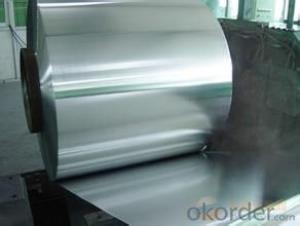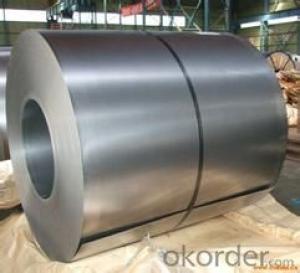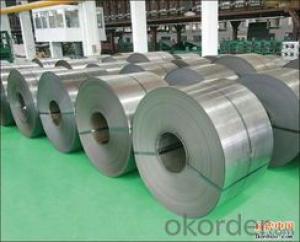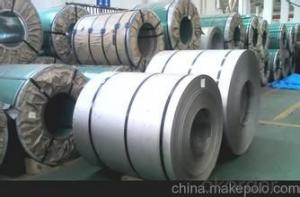good cold rolled steel coil / sheet SPCCT-SB
- Loading Port:
- China main port
- Payment Terms:
- TT OR LC
- Min Order Qty:
- 30 m.t.
- Supply Capability:
- 5000000 m.t./month
OKorder Service Pledge
OKorder Financial Service
You Might Also Like
Characteristics:
1. Commercial quality suitable for bending fabrication and simple forming; this is the type in greatest demand.
2. Drawing quality second only to that of SPCEN. Excellent uniformity.
3. Deep-drawing quality.With metallurgically controlled grain size, it retains its beautiful finish even after being deep-drawn.
4. Extra-low-carbon steel sheets with highest workability
General Application of Cold Rolled Steel Coil:
1. Refrigerators, cabinets, power distribution baords and drums.
2. Automobile floor and roof panels.
3. Automobile fenders and quarter panels
4. Automobile fenders and quarter panels
The raw material of cold rolled steel coil/sheet is high quality hot rolled product, and after pickling, kinds of new technology and new process of global cold rolling production have been applied. Therefore the manufacturing, home appliance, automobile etc. Quality of the goods could be guaranteed. The finished product has a variety of excellent capabilities, such as continuous rolling, degreasing, annealing, skin pass, slitting and cut to length line etc. Along with it many rocessing capability and smooth, flat surface. It’s widely used in outdoor and interior decoration, furnishing
- Q:What are the common maintenance practices for steel coils?
- Common maintenance practices for steel coils include regularly inspecting for any signs of corrosion, cleaning the coils to remove dirt and debris, applying protective coatings or paint to prevent rust, storing the coils in a dry and well-ventilated area, and ensuring proper handling and transportation to avoid any damage. Additionally, it is important to monitor and control the humidity levels around the coils to prevent moisture buildup, which can lead to corrosion.
- Q:What are the different methods of cutting edge trimming for steel coils?
- There are several different methods of cutting edge trimming for steel coils, each with its own advantages and applications. Some of the most commonly used methods include: 1. Shearing: Shearing is a widely used method that involves cutting the edge of the steel coil using a pair of sharp blades. This method is relatively quick and efficient, making it suitable for high-volume production. However, shearing may result in some distortion or burrs along the cut edge. 2. Slitting: Slitting is a process where the steel coil is passed through a set of rotating circular blades that cut the coil into narrower strips. This method is commonly used when precise width control is required, such as in the production of narrow strips or slitting coils into multiple widths. 3. Laser cutting: Laser cutting is a highly precise method that uses a laser beam to cut through the steel coil. This method offers the advantage of producing clean and precise cuts without any distortion or burrs. Laser cutting is often used for complex or intricate shapes that require high accuracy. 4. Plasma cutting: Plasma cutting involves using a jet of ionized gas to cut through the steel coil. This method is particularly suitable for cutting thicker materials or for applications where high cutting speeds are required. Plasma cutting can produce clean and smooth cuts, although the edge may have a slight bevel. 5. Waterjet cutting: Waterjet cutting utilizes a high-pressure jet of water mixed with an abrasive material to cut through the steel coil. This method is highly versatile and can cut through a wide range of materials and thicknesses. Waterjet cutting is known for its ability to produce precise cuts without any heat-affected zone. 6. Sawing: Sawing is a traditional method that involves using a rotating saw blade to cut through the steel coil. This method is commonly used for thicker materials or when a rougher cut is acceptable. Sawing can be performed manually or using automated sawing machines. Each of these methods has its own advantages and considerations, and the choice of method depends on factors such as the required accuracy, production volume, material thickness, and desired edge quality.
- Q:What are the different types of steel coil slitting processes?
- There are several types of steel coil slitting processes, including rotary slitting, loop slitting, and pull-through slitting.
- Q:How do steel coils contribute to durability and longevity in products?
- Steel coils contribute to durability and longevity in products due to their inherent strength and resistance to corrosion. By using steel coils as a material, products benefit from enhanced structural integrity and the ability to withstand heavy loads, mechanical stress, and harsh environmental conditions. The flexibility and resilience of steel coils also ensure that products can maintain their shape and functionality over a prolonged period, making them highly durable and long-lasting.
- Q:so i just bought a stainless steel bracelet.......and recently found out that stainless steel isnt actually stainless..........will turpentine ruin it
- real s/steel is nickel and chrome, however manufacturers of kitchenware, e.g s/teel cutlery use the cheaper version of nickel chrome and iron, that is why some s/steel products rust, so if you want to test any products carry asmall magnet and test the article
- Q:So what's harder gold or steel
- Steel Gold is a soft metal, that's why people bite it to make sure it is real.
- Q:Are steel coils used in HVAC systems?
- Yes, steel coils are commonly used in HVAC systems. They are used in air conditioning units and heat pumps to transfer heat between the refrigerant and the surrounding air, thereby cooling or heating the space. Steel coils are efficient in heat exchange due to their high thermal conductivity and durability.
- Q:How are steel coils used in the manufacturing of industrial equipment?
- Due to their versatility and strength, steel coils find common application in the manufacturing of industrial equipment. Typically crafted from high-quality steel, these coils are shaped into a coiled form for convenient transportation and storage purposes. One of the primary purposes of steel coils in the manufacturing of industrial equipment is the creation of structural components. Often, these coils are cut, shaped, and welded to produce various parts and structures that offer support and stability to the equipment. For instance, frames, beams, and brackets, which serve as the backbone of heavy machinery, can be constructed using steel coils. Moreover, steel coils are utilized in the production of mechanical components like gears, shafts, and bearings. These components necessitate high strength and durability to withstand the demanding loads and harsh conditions encountered in industrial settings. By employing steel coils, manufacturers can ensure that these parts possess the requisite strength and resilience for reliable performance. Additionally, steel coils are incorporated into the manufacturing of equipment surfaces that require corrosion resistance or aesthetic appeal. Steel with specific coatings or finishes can be rolled into coils to create sheets or plates, which are employed in constructing outer casings, panels, or covers for industrial equipment. These coatings not only protect the equipment from environmental factors but also enhance its visual appeal. Furthermore, steel coils can be transformed into pipes and tubes, which are essential components in numerous industrial applications. These pipes serve the purpose of transporting various fluids, gases, or materials within the equipment. The strength and structural integrity of steel coils guarantee that the pipes can endure high pressure, temperature, and mechanical stress, rendering them suitable for demanding industrial environments. In summary, steel coils occupy a vital role in the manufacturing of industrial equipment. They are utilized in fabricating structural components, mechanical parts, surface finishes, and pipes. The versatility, strength, and durability exhibited by steel coils make them the preferred choice in the industrial equipment manufacturing industry.
- Q:What are the main factors that affect the corrosion resistance of steel coils?
- The main factors that affect the corrosion resistance of steel coils include the composition of the steel, the presence of impurities, the surface finish, the environmental conditions, and the protective coatings applied to the steel.
- Q:For example, (and this is weird) if I were wearing a steel collar and I needed some way to remove it, with limited supplies.Force is difficult because it would be around my neck.Chemical cominations are great- but they have to use VERY common products. And I'm not sure what to use.Other ideas?
- Your best bet would be a grinding wheel attached to a small electric motor. Even if you slipped, your skin is too soft to be cut by the dull wheel. Steel, however, is easily cut. But perhaps you don't have access to electricity or pressurized air to run such a tool. In that case, a simple file would work well, though you'd be somewhat more likely to injure yourself. If you had no tools, but access to whatever chemicals you wanted, you could try a weak acid. This would take a long time, and require constant scrubbing to bring fresh acid into the pits in the metal, but it would eventually eat through the collar.
1. Manufacturer Overview |
|
|---|---|
| Location | |
| Year Established | |
| Annual Output Value | |
| Main Markets | |
| Company Certifications | |
2. Manufacturer Certificates |
|
|---|---|
| a) Certification Name | |
| Range | |
| Reference | |
| Validity Period | |
3. Manufacturer Capability |
|
|---|---|
| a)Trade Capacity | |
| Nearest Port | |
| Export Percentage | |
| No.of Employees in Trade Department | |
| Language Spoken: | |
| b)Factory Information | |
| Factory Size: | |
| No. of Production Lines | |
| Contract Manufacturing | |
| Product Price Range | |
Send your message to us
good cold rolled steel coil / sheet SPCCT-SB
- Loading Port:
- China main port
- Payment Terms:
- TT OR LC
- Min Order Qty:
- 30 m.t.
- Supply Capability:
- 5000000 m.t./month
OKorder Service Pledge
OKorder Financial Service
Similar products
New products
Hot products
Related keywords































